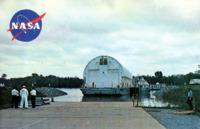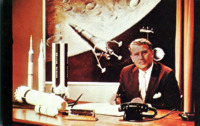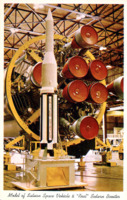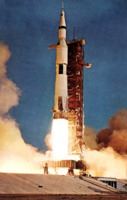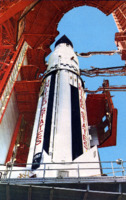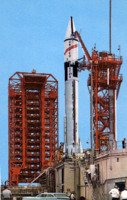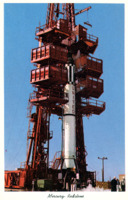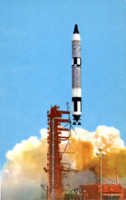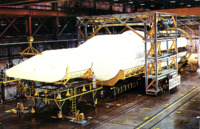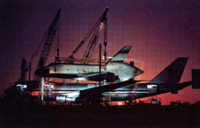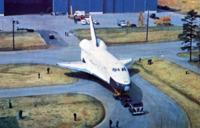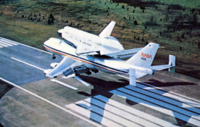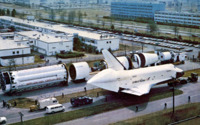
Browse Items (15 total)
Sort by:
-
George C. Marshall Space Flight Center
Back: The George C. Marshall Space Flight Center (MSFC), Huntsville, Alabama
Saturn rocket booster barge at dock on Tennessee River. Barge is used to carry boosters from MSFC at Redstone Arsenal, Ala., to NASA - Kennedy Space Center, Fla., for launch. -
Dr. Wernher von Braun
Back: Dr. Wernher von Braun, director of the NASA - Marshall Space Flight Center, is shown with rocket models and hardware at the Huntsville, Alabama space installation. -
Model of Saturn Space Vehicle & "Real" Saturn Booster
Front: Model of Saturn Space Vehicle & "Real" Saturn Booster.
Back: SCALE MODEL, SATURN SPACE VEHICLE AND "REAL" SATURN BOOSTER
A one-tenth scale model of the Saturn Space vehicle is shown here behind a "real" Saturn booster at the assembly area of the NASA Marshall Space Flight Center, Huntsville, Alabama. The big booster is capable of developing 1.5 million pounds thrust. An assembled vehicle stands 162 feet high. -
Saturn V Launch
Back: This Is the National Aeronautics and Space Administration's Apollo/Saturn V vehicle, used to place man on the moon. The Saturn V vehicle, developing 7.6 million pounds thrust, was developed under the direction of the NASA-Marshall Space Flight Center, Huntsville, Ala. -
"NASA'S SA-5 undergoing pre-lounch check-out."
Back: NASA'S SA-5 undergoing pre-launch check-out. The Saturn is the free-world's largest space booster. It develops a million and a half pounds thrust. The NASA Marshall Space Flight Center at Huntsville. Alabama, has been developing and providing rockets for our space achievements since the very beginning of our entry into this field. -
Centaur II undergoes pre-launch tests
Back: Centaur II, our first space vehicle to use liquid hydrogen as a propellent, undergoes pre-launch tests.
The NASA Marshall Space Flight Center at Huntsville, Alabama, has been developing and providing rockets for our space achievements since the very beginning of our entry into this field. -
Mercury Redstone
Front: Mercury Redstone
Back: National Aeronautics and Space Administration's "Mercury-Redstone" being readied for launch at the Cape Kennedy launch site. The rocket was provided by the NASA George C. Marshall Space Flight Center, Huntsville, Alabama. -
Gemini - Titan I Lifting Off Launching Pad
Back: Gemini-Titan 1 lifting off launching pad on its maiden voyage, testing spacecraft and vehicle. The Gemini is the first of NASA's two-man spacecrafts. The NASA Marshall Space Flight Center at Huntsville, Alabama, has been developing and providing rockets for our space achievements since the very beginning of our entry into this field. -
Saturn I Space Vehicle
Back: A Saturn I space vehicle, developed by the National Aeronautics and Space Administration's Marshall Space Flight Center. Huntsville, Ala., is launched from Cape Kennedy, Fla. The Saturn I weighs more than a million pounds at liftoff, and generates a maximum of 32,000,000 horsepower. It is a fore-runner of the Saturn V moon rocket being developed by MSFC. Huntsville. -
First Flight Configuration of the Saturn C-1
Back: The first flight configuration of the giant Saturn C-1 rocket is seen at the George C. Marshall Space Flight Center, N.A.S.A. Huntsville, Ala. The C-1 will be capable of placing about 10 tons into low earth orbit. -
Enterprise Being Unloaded from 747 Carrier
Back: Enterprise being unloaded from 747 Carrier. -
Enterprise's Home for 1978
Back: Enterprise's home for 1978. -
Space Shuttle Enterprise Lands at Redstone Arsenal Airfield March 13
Back: Space Shuttle Enterprise lands at Redstone Arsenal Airfield March 13, 1978. -
Preparations for Unloading Enterprise from 747 Carrier.
Back: Preparations for unloading Enterprise from 747 Carrier. -
Enterprise Passing a Saturn 1B
Back: The Old and the New, Enterprise passing a Saturn 1B.
